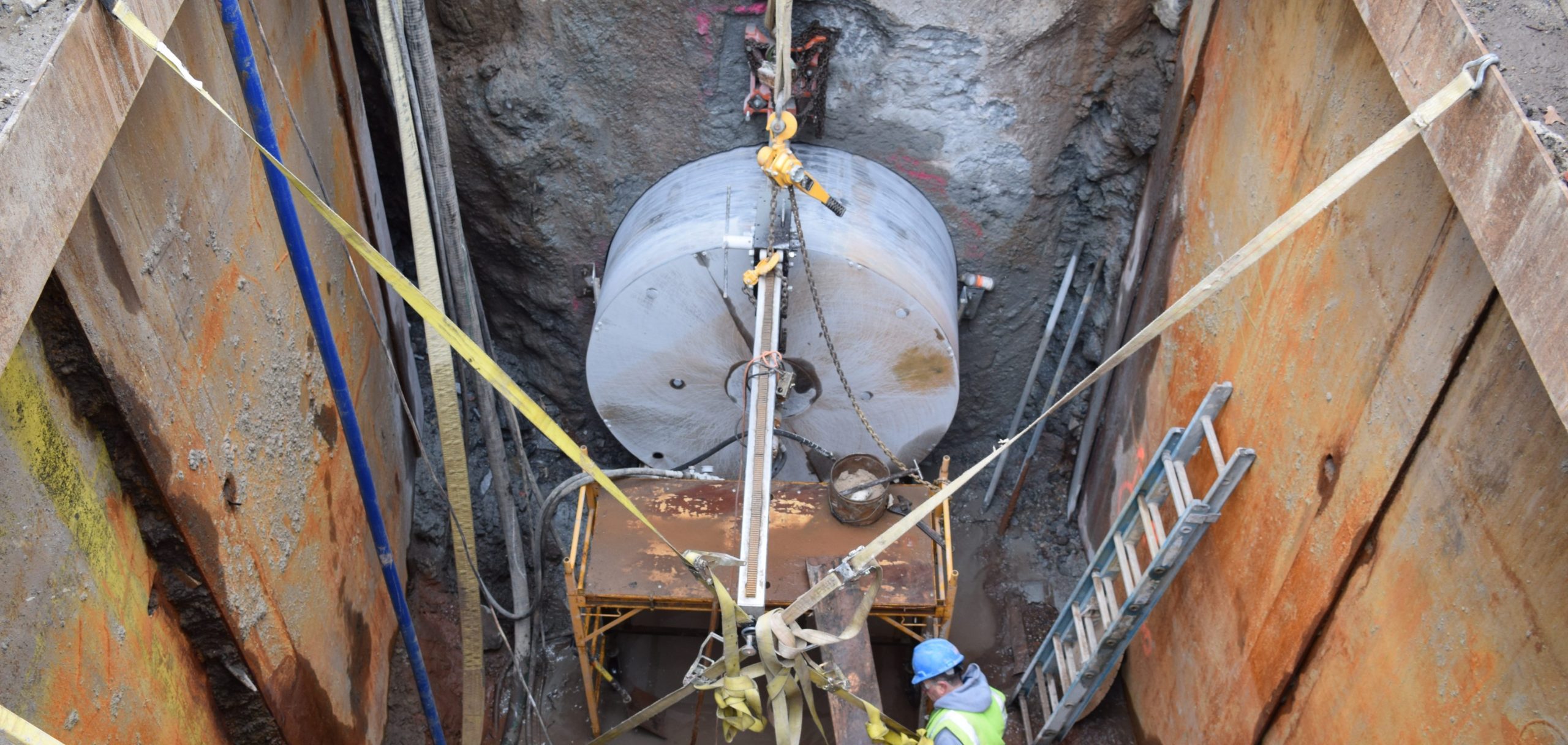
Where There’s a Drill…

…There’s a Way
Large-Diameter Core Drilling Creates Path for NYC Water Siphon
New York City’s Department of Environmental Protection (NYCDEP) has constructed a 72-inch-diameter water siphon to replace two existing, subaqueous water siphons located beneath Upper New York Bay between Bay Ridge, Brooklyn and Tompkinsville, Staten Island. The new $250 million siphon, now complete, provides five million gallons of water per day to these areas. However, a 48-inchthick reinforced concrete slurry wall stood in the way of the new construction and a path through it had to be created.

An angled 72-inch-diameter opening was required 25 feet below ground in Bay Ridge, New York.
New York City currently maintains two existing siphons, which provide a secondary/back-up water supply for City Water Tunnel No. 2, the main water supply for Staten Island. The U.S. Army Corps of Engineers (USACE)/Port Authority of New York & New Jersey (PANYNJ), as part of their New York and New Jersey Harbor Deepening Project, are dredging this channel to a depth of approximately 54 feet below mean low water (MLW). The existing siphons are situated at a depth that could be compromised by the dredging in the channel.
The new 72-inch siphon replaces two existing siphons and provides the necessary back-up water supply from Brooklyn to Staten Island. In emergency situations, it has the capacity to supply an average of 50 million gallons of water per day, maintaining a redundant and reliable supply of water to Staten Island. The project also involved the construction of shafts on both the Brooklyn and Staten Island sides of the harbor along with water transmission mains and other related infrastructure improvements. This provided connections to the existing water supply systems and to a chlorine station adjacent to the Staten Island shaft.
In January 2016, construction of the new siphon system approached the Bay Ridge concrete slurry wall at Front Staten Island and Shore Road at 83rd Street in Brooklyn. General contractor Judlau OHL Contracting of College Point, New York, employed the services of CSDA member J.P. Hogan Coring & Sawing Corp. of Staten Island to breach the wall so that the 72-inch-diameter supply line to the Brooklyn shaft side of the siphon could be attached. The shaft was already completed and a cap installed prior to the cutting contractor arriving at the jobsite.
The proximity of the finished shaft to the marked area for penetration prevented the use of any percussion equipment, as high vibration could have compromised the integrity of the shaft and slurry wall. That, and the fact that the work area was 25 feet below ground.

On the opposite side of the slurry wall was the connection point for the new siphon system.
The general contractor specified that a smooth, perfectly round hole was required to facilitate a specific link seal for the new water line, so J.P. Hogan planned to create a 79-inch-diameter core hole through the 48-inch-thick wall. The use of a diamond core bit with core drilling equipment would achieve the desired result while creating less noise, vibration and debris than other traditional demolition methods.
Prior to starting work on the slurry wall, the core drilling contractor had to find a manufacturer that could produce a custom 79-inch-diameter, 5-foot-long bit. CSDA member Husqvarna Construction Products was selected because of the company’s expertise in fabricating large-diameter core bits and the contractor having confidence in the quality of the finished product. A hydraulic 45.6 cubic inch core drill motor from fellow member Diamond Products was selected to power the bit and the company also supplied a M6 rig.
“When bits of this diameter are used to drill horizontal holes, they have a tendency to partially collapse on the open end,” explained Bernadette Hogan, president of J.P. Hogan. “So we mounted an internal truss to prevent the bit from falling out of round.”
The core drilling team mobilized and transported all tools and equipment to the work area—a 15-foot-long, 25-foot-wide excavated opening that was 25 feet deep. Equipment was lowered down into the work area by crane and ladders securely positioned for operator access.
The drill rig was mounted to the heavily-reinforced concrete slurry wall and on the opposite side of it was the capped connection point. J.P. Hogan operators, positioned on a 5-foot work platform, were about to set up the drill motor and bit, when site engineers discovered the hole could not be drilled through the wall straight on. Using a laser device, the correct drilling angle was determined to be a 15-degree compound angle and the operators made the necessary adjustments.

Drilling stopped 10 inches short of the total wall thickness so the bit could be removed safely.
As the contractor was now performing angled core drilling with a 79-inch-diameter bit, additional care had to be taken to maintain accuracy and not damage the bit. Drilling began with only a portion of the bit’s total circumference making contact with the concrete. In order to prevent the bit from traveling or chattering, J.P. Hogan mounted Teflonlined steel guides. These guides proved critical to getting the diamond bit engaged in the concrete.
Another consideration was how deep to penetrate the wall, as there was concern that the large core would break free prematurely and destroy the bit. The contractor planned to drill through the last mat of steel rebar in the wall, leaving approximately 10 inches of concrete to support the core while the bit was removed.
Drilling got underway and the operator controlled coring speed at 41 RPM, adjusting as necessary when the bit encountered any steel reinforcement. Work was completed over eight man days, when the team from J.P. Hogan reached the specified core drilling depth. This duration included some delays due to New York winter weather that averaged low temperatures between 25 and 30 degrees Farenheit.
The contractor’s plan to core drill through the last matt of rebar then leave the core in place worked. The last 10 inches of concrete supported the weight of the 79-inch-diameter core while the core bit was removed. Once the core drilling team had demobilized and exited the work area, the general contractor tapped the core with a back hoe and the concrete broke free. The 48-inch-long core was extracted by crane and weighed 23,000 pounds.
“J.P. Hogan did a great job coring the required 79-inchdiameter hole. This allowed the timely installation of the 72-inch inside diameter pipe and kept our work on schedule,” said Vladimir
Gotman, project manager for Judlau OHL Contracting. With help from this professional concrete sawing and drilling contractor, Judlau OHL Contracting completed its work for the NYCDEP and the new water siphon is now operational. The concrete slurry wall job is a great example of how large-diameter core drilling can be a cost effective, faster and safer alternative than some other demolition techniques. Where there’s a (core) drill, there’s a way.
Company Profile
J.P. Hogan Coring & Sawing Corp. is a full service concrete cutting company located in Staten Island, New York. The company first joined CSDA in 2006 and has been in business for over 20 years. J.P. Hogan has 36 employees, over 20 trucks and is a WBE/DBE certified contractor. The company offers the concrete cutting services of core drilling, slab sawing, wall sawing, hand sawing, wire sawing and selective demolition.
Resources
General Contractor:
Judlau OHL Contracting
Sawing and Drilling Contractor:
J.P. Hogan Coring & Sawing, Inc.
Staten Island, New York
Phone: 718-761-7014
Email: jmack@888jphogan.com
Website: www.888jphogan.com
Methods Used: Core Drilling













![Semper Paratus [Always Ready]](https://www.concreteopenings.com/wp-content/uploads/2014/11/1-Photo-6-e1424382046143-scaled.jpg)
